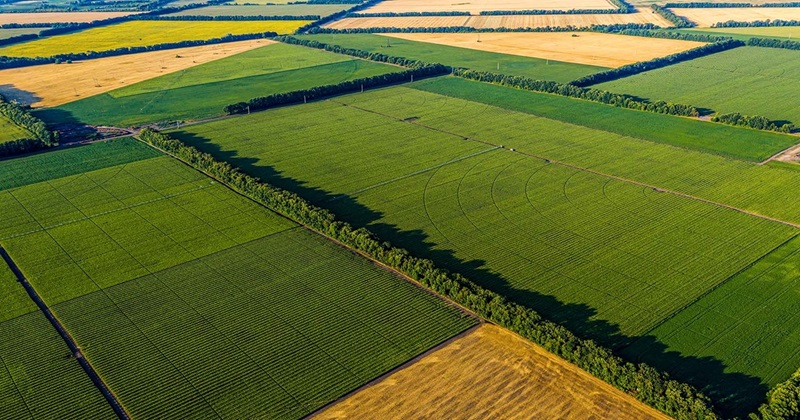Top 6 Best States for Farmland in the US
Choosing the right state for farmland is key for anyone interested in farming or investing in agricultural land. Each state offers unique benefits, from soil quality to climate to the cost of land. This guide will help you understand which states provide the best opportunities for owning farmland.
In this article, we will explore where you can find the most promising land for your agricultural needs. We look at states that offer fertile soil, supportive farming communities, and a strong return on investment. Whether you are a seasoned farmer or a new investor, these insights will help you make an informed decision.
Kentucky: The Bluegrass State’s Farmland
Kentucky’s reputation for having some of the most fertile farmland is well-founded. Known for its signature bluegrass and rolling hills, the state offers land at an average of $4,500 per acre, providing excellent value. Not only does Kentucky have a storied history in horse breeding and racing, but it also stands tall in tobacco and corn production. The state’s agricultural programs offer robust support, ensuring that farmers have the resources they need to thrive.
The sense of community among Kentucky farmers is palpable. Newcomers to farming in Kentucky often speak of the warm welcome and ongoing support they receive from local networks. The state’s focus is not just on maintaining current agricultural standards but also on embracing new farming technologies and practices that promise a bright future for its agriculture sector.
Missouri: A Land of Diverse Agricultural Opportunities
In Missouri, the diversity of the landscape mirrors the diversity of its agricultural opportunities. With Living the Dream Land at the forefront of connecting people to their dream properties, the state’s potential for both crop and livestock farming is vast. Missouri’s commitment to agriculture shines through its competitive land prices and a strong sense of camaraderie among farmers and landowners.
Living the Dream Land has become synonymous with Missouri’s agricultural scene. They not only assist in finding the right tract of land but also support buyers through the process of making the land their own. Missouri’s affordability and richness in resources make it a standout option for those looking to enter the farming industry or expand their existing operations.
Iowa: The Corn State
Iowa’s nickname as ‘The Corn State’ is a badge worn with pride, as the state’s rich soil churns out a significant portion of the nation’s corn and soybeans. With farmland averaging $6,000 per acre, investment in Iowa’s agriculture is both a strategic and profitable venture. The state’s infrastructure is particularly accommodating for agribusiness, boasting an array of modern facilities and an extensive transportation network.
Farmers in Iowa are never alone; they are backed by a supportive community that spans generations. Newcomers and seasoned farmers alike are welcomed into a fold that is as much about growing crops as it is about growing relationships. Iowa’s investment in its people and their farming endeavors is reflected in the strong and resilient agriculture sector.
Nebraska: The Beef State
Nebraska’s nickname, ‘The Beef State,’ is a testament to its premier status in cattle farming and beef production. The average land cost is around $4,500 per acre, offering wide-open spaces ideal for both livestock and crops. The state’s agricultural industry is bolstered by supportive policies and a community that values growth and innovation.
The climate and natural resources in Nebraska are perfectly suited for a range of farming activities, making it a versatile choice for agricultural investments. The state’s commitment to the agricultural sector is evident in its efforts to sustain and grow farming through community support and government programs aimed at providing farmers with the best possible environment for success.
Texas: A Leader in Cotton and Livestock
Texas is a land of opportunity for farmers, with its diverse climate and sprawling landscapes offering a wide range of farming possibilities. Leading in cotton production and playing a significant role in the livestock industry, Texas farmland is priced at an accessible average of $3,000 per acre. The state’s approach to agriculture is flexible, accommodating both traditional ranching methods and modern, innovative practices.
Texas boasts a long growing season and a wealth of market access points, positioning it as a prime location for ambitious farming operations. The variety of farming options in Texas means that there is something for every agricultural entrepreneur, whether they are looking to start small or scale up to a larger operation.
Oregon: The Sustainable Farming Champion
Oregon’s commitment to sustainable and organic farming sets it apart as a leader in environmentally responsible agriculture. With an average cost of $5,000 per acre, the state’s farmland reflects its premium quality and the high demand for sustainable produce. Oregon farmers are at the forefront of innovative practices that maintain ecological balance while yielding high-quality crops.
The farming community in Oregon is dedicated to preserving the natural beauty and fertility of the land. The state’s push for sustainable agriculture has attracted a new wave of farmers who are as concerned about the health of the environment as they are about their harvests. Oregon’s farmland is not just a piece of property; it’s a commitment to a greener, more sustainable future.
Conclusion
The search for the best farmland in the US leads to diverse landscapes, each with its unique advantages. From the tobacco fields of Kentucky to the sustainable farms of Oregon, the opportunities for agricultural investment are boundless. Each state offers a distinctive combination of economic value, community support, and agricultural potential, making the US a global leader in agricultural diversity and innovation.
For those looking to venture into the agricultural sector, these states present the best opportunities for growth and success. As the industry evolves, these regions stand ready to support the next generation of farmers and investors in realizing the full potential of American farmland.



